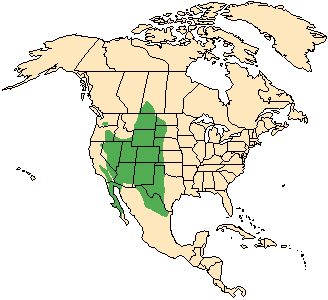![]() Return
to Artiodactyla
Return
to Artiodactyla
Classification
|
 Antilocapra
americana
Antilocapra
americana
Pronghorn
![]()
Taxonomy
 |
 |
 |
Click on the pictures above for a larger view of the
photographs
|
||
General Characteristics
Body Length: Up to 150 cm / 5ft.
Shoulder Height: Up to 102 cm / 3.4 ft.
Tail Length: 7.5-10 cm / 3-4 in.
Weight: Usually 38-41 kg / 84-90 lb.The light reddish tan upper coat is primarily composed of long stiff bristles, with a relatively sparse undercoat. Sharply contrasting with the upper coat are the white undersides, including the insides of the legs, whose coloration extends almost halfway up the sides. Additional white markings include two crescents on the throat (connected to each other and to the white undersides with a thin white line) and the lower half of the face. On the rump is a large circular patch of 7-10 cm / 2.8-4 inch long white hairs which can be erected as a signal. Adult males have dark faces, as well as a blackish spot on the cheek and jaw line and a small dark neck mane. Both sexes carry horns (although in females they are stunted and virtually undeveloped), which are composed of a flattened bony knob. On top of these is grown a keratinous sheath which is shed annually like antlers. In mature males these black horn sheaths diverge above the eyes, sending a small triangular protrusion forward, while the rest of the now tubular sheath grows upwards, curving towards the rear to a length of about 25 cm / 10 inches.
Ontogeny and Reproduction
Gestation Period: About 250 days.
Young per Birth: 1-2
Weaning: After 4-5 months.
Sexual Maturity: At 15-16 months, although males are generally not socially mature until 3 years.
Life span: 7-10 years.Young are born in May, and reach adult size at around 6 months. After birth, the young lie hidden in the grass, placed 80-100 meters / 256-320 feet away from their twin. At the early age of 4 days old the fawn can outrun a human!
Ecology and Behavior
The pronghorn is active throughout the 24-hour day, with slight peaks in activity at dawn and dusk. The daily foraging expeditions of a pronghorn herd vary from 0.1-0.8 kilometers / 0.06-0.48 miles in the spring and summer to 3.2-9.7 kilometers / 1.9-5.8 miles in the fall and winter. The fastest land mammal in the Western Hemisphere, as well as one of the fastest land mammals, the pronghorn also has excellent stamina, unlike the cheetah. Normally running at speeds of 40 kmph / 24 mph, its maximum speed of 95 kmph / 57 mph can be held for distances up to 15 kilometers / 9 miles. These speeds are reached on hard ground, and consist of leaps covering 3-6 meters / 10-20 feet. The pronghorn is also a good swimmer. Instead of jumping over obstacles like deer, pronghorns prefer to go under them. With excellent eyesight, the pronghorn can detect potential sources of danger from several kilometers away. When a close source of danger is detected, pronghorns spread the hairs of their white rump patch into a puffy "flower", which, when seen by other pronghorns, causes them to spread their patches. During summer, males over three years old compete amongst each other for the possession of a territory, 0.23-4.34 square kilometers in size. These territories normally have physical boundaries and may be separated from each other by up to 0.8 kilometers / 0.48 miles of "free" land. The male marks his range with urine, feces, and glandular secretions, defending it from rivals with aggressive stares and occasional fights. The wide variety of vocalizations the pronghorn makes includes grunts, bleats, and roars.Family group: From March to October there are small, sexually segregated herds of up to 25 individuals, while in winter large mixed herds form with up to 1,000 animals.
Diet: Grasses, leaves, cacti.
Main Predators: For the young; coyotes, foxes, raptors.
Distribution
Open areas in tall and short grass prairies and deserts in North America.

Range Map (Redrawn from Burt and Grossenheider, 1976)
Conservation Status
While as a species the pronghorn is not threatened, A. a. mexicana is classified as a low risk, conservation dependent species by the IUCN (1996). More serious, A. a. sonoriensis is classified as endangered, while A. a. peninsularis is considered to be a critically endangered subspecies.
Remarks
Mentioned in the famous (and misleading) song "Home on the Range", the pronghorn is known by many as the American 'antelope' ["Oh give me a home where the buffalo (actually bison) roam, where the deer and the antelope (actually pronghorn) play..."]. However, this unique ungulate is not a true antelope, but instead occupies a unique and uncertain taxonomic position between deer and bovids. The origin of the name pronghorn is fairly obvious when looking at mature males - their 'horns' are forked.
Anthalops (Greek) a horned animal [probably from anthos (Greek) a flower and ops (Greek) the eye which refers to the beautiful eyes of antelope]; capra (Latin) a she-goat. -anus (Latin) suffix meaning belonging to.
Literature Cited
Burt, W. H., and R. P. Grossenheider. 1976. A Field Guide to the Mammals of North America North of Mexico, Third Edition. A Peterson Field Guide. Boston: Houghton Mifflin CompanyGeist, V. 1990. Pronghorns. In Grzimek's Encyclopedia of Mammals. Edited by S. P. Parker. New York: McGraw-Hill. pp. 278-285.
Nowak, R. M. [editor]. 1991. Walker's Mammals of the World (Fifth Edition). Baltimore: The Johns Hopkins University Press.
Wilson, D. E., and D. M. Reeder [editors]. 1993. Mammal Species of the World (Second Edition). Washington: Smithsonian Institution Press. Available online at http://nmnhwww.si.edu/msw/
Return to Artiodactyla

![]()
© Brent Huffman, www.ultimateungulate.com |
|
|